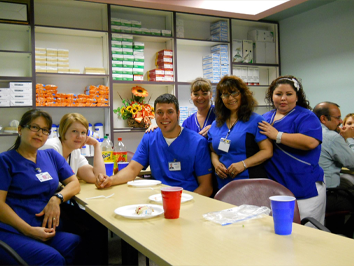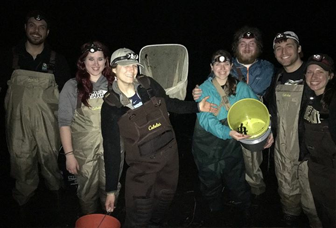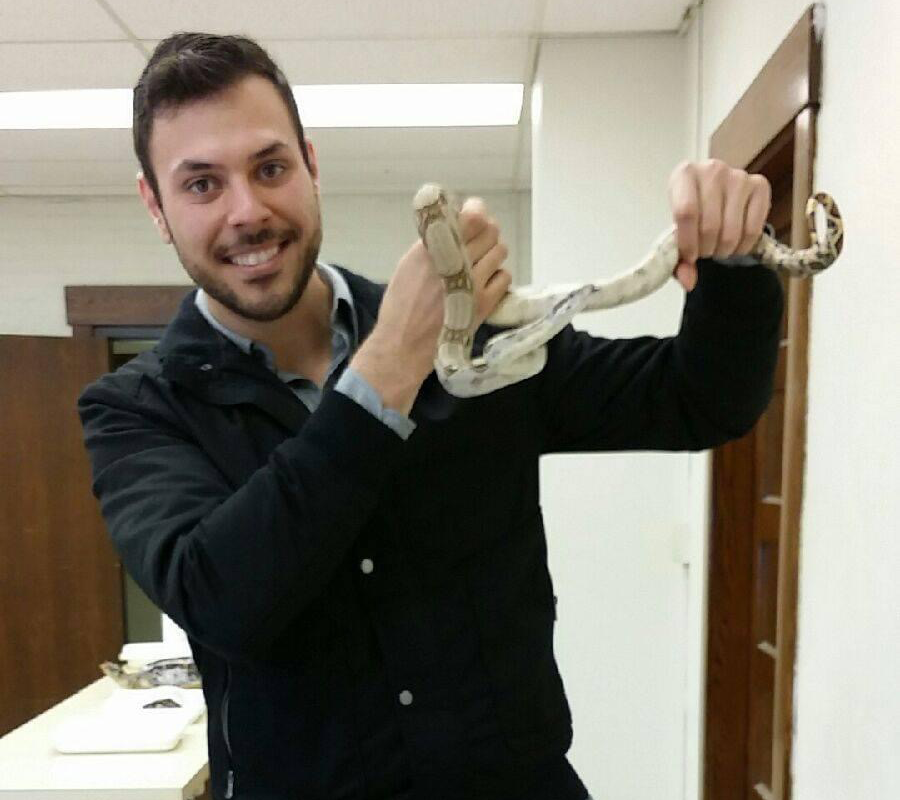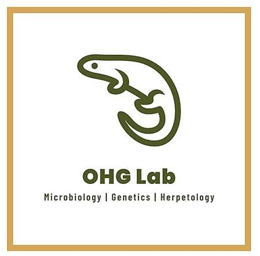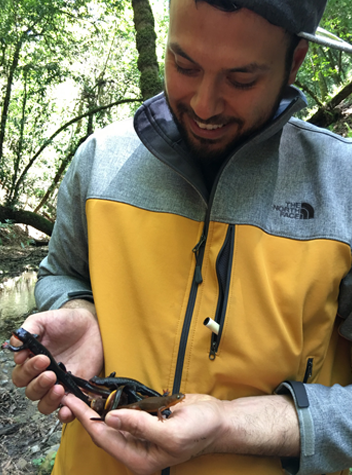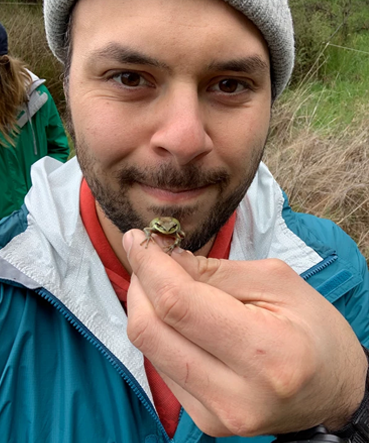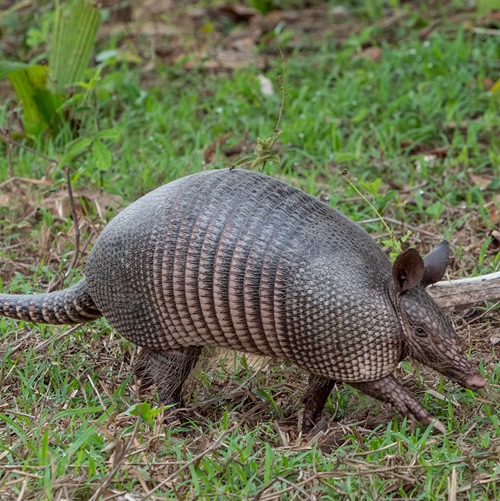Hernandez-Gomez Tabbed as Outstanding Young FNR Alumnus
“Chance encounters are often the routes through which opportunities manifest themselves.” – Ashwin Sanghi
As a child growing up in El Paso, Texas, Dr. Obed Hernández-Gómez enjoyed wildlife, but his Mexican American culture, and his mother specifically, encouraged him to get a job where he could contribute to society in some way.
“Studying animals to my mom seemed like I was going to get nowhere,” Hernández-Gómez recalls. “There’s no money there, go become a doctor. So that got pushed on me really early in life and I kept it. In high school I got my nursing degree (LVN) and I really planned to go to medical school. I actually worked as a nurse for 10 years, even when I was getting my PhD at Purdue. But being a nurse taught me that I didn’t like the medical field. I really loved the science behind medicine, like learning pharmacology, learning about genetics and learning about microbiology. All of those things really excited me.”
As an undergraduate student at Texas Tech, where he was a pre-med major, Hernández-Gómez took a class where students canoed the Green River in Utah for two weeks, a chance encounter that began changing the trajectory of his life and career path. He loved it and that sparked him to start taking more ecology-based classes. After graduating from Texas Tech in 2010, Hernández-Gómez went home to reassess his career goals, but went ahead and interviewed for medical school just in case.
“I told them during my medical school interview that if they didn’t take me that I was going to become an ecologist because that was really exciting,” Hernández-Gómez said. “They were like then why are you interviewing. I interviewed just to prove to myself that I could and that I could apply. I saved myself $250,000 by not going.
“I just don’t like working with humans. For some reason I would rather work with animals, they make better patients in my mind and they deserve some of our attention. My research still kind of mirrors the medical aspect of things. I work with a lot of pre-med students in my lab and I am always sharing that message, that you can do cool research that is worth something to society, whether you are doing it on humans or wildlife. It’s still important and still providing answers.”
With medicine off the table, Hernández-Gómez began looking into programs that would allow him to become a marine biologist. Purdue professor John Bickham was studying whale genomics. Bickham had connections to Texas Tech and had studied with some of Hernández-Gómez’ professors there, so it seemed like a perfect fit. After being awarded a doctoral fellowship based on diversity, Obed was on his way to West Lafayette.
As fate would have it, yet another curve ball was thrown his way. Bickham left Purdue as Hernández- Gómez arrived and he wound up working in Dr. Rod Williams’ hellbender lab. The rest, as they say, is history.
“What really excited me about the project with hellbenders was that it first looked at wounds,” Hernández-Gómez shared. “We had Ozark hellbenders in Missouri with mystery wounds. We did not know what formed these wounds. Someone had to do the microbiome work, and that was something that merged my previous interests in medical science with the love of wildlife I have had since I was a child. It sort of became the perfect marriage. It allowed me to really study something that I was super excited about in a really cool system.”
The move to West Lafayette was not without its challenges for Hernández-Gómez, facing winter for the first time as well as dealing with the culture shock of moving from a community that was 80 percent Mexican American to Purdue where he was a minority. But, a collaborative learning environment among the graduate students helped with the adjustments.
“It was a big learning experience and it was a big risk to move that far from home, but I think it paid off, because I ended up having a great experience and being put in a great trajectory,” Hernández-Gómez said. “The first thing I fell in love with was the genetics lab, how big it was and how many resources were available for us. I’ve never seen that large of a shared and communal space, where the grad students actually become each other’s teachers. In Rod’s lab, every grad student was doing something different, which allowed you to become independent and really an expert in your field. I was the sole genetics grad student in our lab for a while, so the DeWoody Lab students taught me a lot of things.”
In addition to learning his respective field of study within the Williams hellbender lab, outreach was an area of emphasis, not just doing the science, but being able to communicate that research to the public as well as to the scientific community. That is something that left a lasting impact on Hernández-Gómez and is something he emphasizes to his own lab students at today.
“A lot of researchers don’t know how to communicate their science, but Rod really took that as a mission for the lab as well as the fact that Purdue is a land-grant school, so we all had to do yearly outreach events, and we had to learn how to deliver a two-minute elevator speech on our research in plain English,” Hernández-Gómez said. “I think that really pushed me far and has really allowed me to expand my outreach program here in California as well, because I have to start from scratch.”
The Williams lab hosted an annual Help the Hellbender Day outreach program in Lafayette, Corydon and Evansville, Indiana, with events focused on hellbender conservation. Hernández-Gómez also presented amphibian conservation activities as part of summer camp at the Columbian Park Zoo and talked about amphibian microbiome research at Wednesdays in the Wild at Lily Nature Center.
After five years in the Williams Lab, Hernández-Gómez graduated with his PhD in philosophy (2017), but not before making an impact on the Purdue and Greater Lafayette communities through his outreach work. Hernández-Gómez worked with underrepresented youth through mentorship at an English as a second language science program, and also as an advocate for his fellow LatinX students on campus. He mentored undergraduate students through the Louis Stokes Alliances for Minority Participation program, and developed a science motivational outreach program called Excelling in Science as an ESL Student, aimed at elementary and middle school English as a second language students.
Hernández-Gómez was the President of the Purdue Latino Graduate Student Organization and co- chaired a campus-wide research symposium featuring LatinX graduate students. He also organized a two-day workshop at Ivy Tech Community College – the Bridge Program – focused on helping community college students plan their transfer to a four-year institution.
Those community outreach efforts followed him as he headed to California, where he completed two postdoctoral fellowships at the University of California-Berkeley before accepting the position of assistant professor of herpetology, genetics and microbiology at Dominican University of California.
Hernández-Gómez acted as a Spanish-speaking mentor in the Bay Area Scientists in Schools and Be a Scientist programs in the Bay Area. At Dominican, he is a part of the Diversity Action Group, a school- wide committee for campus outreach and action on diversity, equity and inclusion.
His community engagement activities often combine his interests of increasing representation for minorities as well as spreading the message of conservation to youth of all ages. From participating in the annual Save the Frogs Day event geared toward first to fifth grade classes at the Museum of Invertebrate Zoology in Berkeley, to delivering his own herpetology show and tell lesson for kindergarten and first graders at Laurel Dell Elementary School in San Rafael, Hernández-Gómez has incorporated outreach into his research. His work also is reaching beyond his immediate circle of influence through the San Diego County Office of Education Science Resource Center’s #ProjectPhenomena, a collaborative effort that helped K-12 teachers develop next generation science standards lesson plans based on amphibian microbiome research.
“One of the drivers for my outreach is that in my time in biology and conservation, I really never see people who look like me,” Hernández-Gómez explains. “When you go to a wildlife conference, there are really no brown people there. That is what I want to change. This is a career that is tough to sell to people who might come from a lower economic status because it does not pay a lot of money and there is not a lot of glory. What I am trying to do is break that misconception. I go in and talk to kids – it might be a lesson just looking at the differences between a mammal and a reptile – but I think the message a lot of these kids get is that they see a brown person coming in and giving that lesson and then they can visualize themselves in that role.
“One of the most rewarding times in my career was at Laurel Elementary School. We were doing a lesson and I had all of my frogs and lizards and I had one little five-year-old Mexican boy come to me and say ‘I want to grow up to be just like you.’ That’s what I am trying to do, to diversify this field and bring in more perspectives, to give power to people who might not have the power to enter the field and do great in it. Those are my drives – conservation and also providing opportunities to people who might have been like me. I love working with kids so that’s where I focus my outreach.”
In addition to impacting the next generation of wildlife experts, both through elementary school outreach and through the students who work in his own lab at Dominican, Hernández-Gómez is conducting groundbreaking research as well.
The OHG lab at Dominican has two main projects. The first group is studying bacteria that live on the skin of salamanders to evaluate which ones are good at killing the amphibian chytrid fungus (Batrachochytrium dendrobatidis) or Bd. The aim is to isolate bacteria that produce metabolites which inhibit the growth of Bd and its sister species Bsal (Batrachochytrium salamandrivorans), that affects mostly salamanders and hasn’t yet been introduced in the United States. The goal is to try to get ahead of the curve so that if the fungus does get introduced a list of probiotics that can be used for conservation purposed already exists.
The team also is working on a project that looks at the distribution of a new fungal disease in pond turtles throughout the Pacific Northwest called shell rot disease, caused by Emydomyces testavorans, which creates infections in the shell that start inside out. Cysts form under the shell and then grow to the outside, which can expose the interior organs and compromise the shell. The OHG lab is developing a DNA assay that they can use to look for the fungus and plans to track the dispersal of the fungus.
Eventually, the OHG lab and its collaborators hope to evaluate whether invasive turtles, or turtles people release in the wild, are carriers of the fungus, which has been found in Washington and California.
“Right now we are just starting to look for it,” Hernández-Gómez explains. “We think that people buy these turtles – the red eared sliders, a common pet turtle – and they get too big to be held in their aquariums, so people go and release them in ponds. That’s how we think the fungus spreads, because it mostly affects wild captive turtles. We think it might be microbiome based but it could be something where if you are raised in a sub-par environment you might be more susceptible. It may be even more complicated than we think, but it’s what we’re doing. It’s really exciting to sort of establish a new line of study.”
Although Hernández-Gómez has a lab and research of his own, he is still very much tied to his colleagues at Purdue, collaborating with them on eight of his 12 publications and keeping tabs on their research. He still attends the biannual hellbender research meetings and talks with the Purdue hellbender group regularly to keep up with what is going on.
“I took care of a bunch of eggs while I was at Purdue, so when I hear that those cohorts that maybe I cared for are being released, I feel proud because I may have taken them out of their egg when they were larvae,” Hernández-Gómez boasts. “There’s still that link, because some of the animals I cared for are still there.”
Many of Hernández-Gómez’s colleagues in the Williams Lab as well as Dr. Jason Hoverman, professor of invertebrate ecology, endorsed his nomination for the Purdue Forestry and Natural Resources Outstanding Young Alumni Award in 2021. Jesse C. Miles penned the nomination letter.
“The simplest part of writing this nomination is knowing how deserving I and many others find Dr. Hernández-Gómez of receiving recognition for his accomplishments,” Miles said. “He excels in his profession as a scholar, scientist and teacher, represents diversity in his field and has continually given back to both the Latino community as well as the community as a whole. Through his broad endeavors, he maintains the highest level of integrity and he continues to collaborate with current and former Purdue scholars, carrying forward a shining example of the university and the Forestry and Natural Resources department.
“The most difficult part of writing this nomination is deciding what aspects of Dr. Hernández-Gómez’s marvelous career to convey. Even greater a challenge is imagining all of the accomplishments he has yet to achieve as a proud Purdue FNR alum.”
The Outstanding Young Alumni award, which will be formally conferred on Hernández-Gómez on April 20, caught its recipient by surprise.
“I didn’t find out I was nominated until I won, but it is very special to me because Jesse (Miles), Rod (Williams), Vanessa (Wuerthner) and others, they have all seen how hard I’ve worked to get to where I am,” Hernández-Gómez shared. “I sometimes don’t see it in myself. I might have publications, but that’s what I do. The fact that they were able to see that in me and view how hard I’ve been working, and feel that all of that hard work is worth something, makes me feel like my life or my career is going in the right direction. It is an honor and I will try to continue to represent Purdue to the fullest.
“It is sort of special to be a role model to other Boilermakers. It sounds weird because I was just a Boilermaker not too long ago, but it does feel like a big responsibility and is something I do take to heart. I hope that people in the future can see that A) it’s doable and B) Purdue is giving you the tools to achieve it, so you can do it yourself as well.”
In addition to a legacy of hard work and dedication to achieving his dreams in his second career as an ecologist, Hernández-Gómez hopes current and future students learn from his story.
“I would suggest they do whatever makes them happy,” Hernández-Gómez said. “If wildlife science is something that really draws you, do it. There are opportunities. Being a wildlife biologist is an opportunity to work with governments, an opportunity to work with researchers, an opportunity for you to make your own path and end up somewhere cool you might not expect. You definitely have to work hard and follow through, but do what makes you happy.
“A lot of people take for granted experiences at Purdue like going away to the Upper Peninsula in Michigan for summer practicum and other super cool experiences you don’t get at other places. Take advantage of every single one of those things, and then lastly, what I want to leave people with is that one of my major joys in life is working with my friends. One of the reasons why achieving 12 publications or getting to where I am right now might not have seemed like a big deal to me at first, is because I’ve been able to make some really good connections with people that are very supportive and all of those friends I have made are the ones who I have published with to date. Make connections while you’re at the school, but also work on your friendships because you never know when those people are going to be your biggest collaborators or biggest sources of support. Taking time outside of work to build those relationships is important.”
Hernández-Gómez will be honored as FNR’s Outstanding Young Alumni Award winner in a virtual ceremony on April 20 alongside two FNR Distinguished Alumnus honorees and two Lifetime Achievement Award winners.
